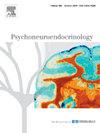幼儿唾液中α-淀粉酶和皮质醇与压力有关的变化模式:与母亲社会心理风险因素的关联。
IF 3.4
2区 医学
Q2 ENDOCRINOLOGY & METABOLISM
引用次数: 0
摘要
我们对家庭层面的风险因素与儿童压力生理学之间关联的理解主要来自于采用 "基于平均值 "而非 "个人层面 "方法的研究。在本研究中,我们采用了基于群体的轨迹建模(一种以人为本的方法)来识别具有类似压力相关交感神经系统(SNS)和下丘脑-垂体-肾上腺轴(HPA)激活模式的儿童,并探讨了这些模式与母亲的社会心理风险之间的关联。参与者为五岁儿童(147 人;52 % 为女性;62 % 为黑人/非裔美国人)及其母亲。在一系列情绪压力任务中,对儿童的唾液进行了四次采样,随后对 sAA 和皮质醇进行了检测,这分别是 SNS 和 HPA 活动的指标。母亲们报告了她们的抑郁和焦虑症状、育儿压力、经济压力和收入情况。结果显示,sAA(低稳定 vs. 高增加)和皮质醇(低稳定 vs. 高下降)浓度的变化有两种与任务相关的模式。收入较低家庭的儿童更有可能表现出 SNS 高增加模式[OR=0.78, 95 % CI (0.64, 0.95)],而母亲有较多焦虑症状[OR=1.06, 95 % CI (1.00, 1.12)]和较多养育压力[OR=1.04, 95 % CI (1.00, 1.07)]的儿童更有可能表现出 HPA 高减少模式。本文讨论了这种以人为本的方法和研究结果对促进我们了解家庭层面的风险因素与儿童压力生理之间关系的意义。本文章由计算机程序翻译,如有差异,请以英文原文为准。
Patterns of stress-related change in salivary alpha-amylase and cortisol among young children: Associations with maternal psychosocial risk factors
Our understanding of associations between family-level risk factors and children’s stress physiology is largely derived from studies that apply “mean-based” rather than “person-level” approaches. In this study, we employed group-based trajectory modeling, a person-centered approach, to identify children with similar patterns of stress-related sympathetic nervous system (SNS) and hypothalamic-pituitary-adrenal (HPA) axis activation, and explored associations between these patterns and maternal psychosocial risk. Participants were five-year-old children (N=147; 52 % female; 62 % Black/African American) and their mothers. Children’s saliva was sampled four times during a series of emotional stressor tasks and later assayed for sAA and cortisol, indexing SNS and HPA activity, respectively. Mothers reported their depressive and anxiety symptoms, parenting stress, financial stress, and income. Results revealed two task-related patterns of change for sAA (Low-Stable vs. High-Increasing) and cortisol (Low-Stable vs. High-Decreasing) concentrations. Children from families with lower income were more likely to exhibit the High-Increasing SNS pattern, [OR=0.78, 95 % CI (0.64, 0.95)], and children of mothers reporting more anxiety symptoms [OR=1.06, 95 % CI (1.00, 1.12)] and more parenting stress [OR=1.04, 95 % CI (1.00, 1.07)] were more likely to show the High-Decreasing HPA pattern. Implications of this person-centered approach and findings for advancing our understanding of associations between family-level risk factors and children’s stress physiology are discussed.
求助全文
通过发布文献求助,成功后即可免费获取论文全文。
去求助
来源期刊

Psychoneuroendocrinology
医学-精神病学
CiteScore
7.40
自引率
8.10%
发文量
268
审稿时长
66 days
期刊介绍:
Psychoneuroendocrinology publishes papers dealing with the interrelated disciplines of psychology, neurobiology, endocrinology, immunology, neurology, and psychiatry, with an emphasis on multidisciplinary studies aiming at integrating these disciplines in terms of either basic research or clinical implications. One of the main goals is to understand how a variety of psychobiological factors interact in the expression of the stress response as it relates to the development and/or maintenance of neuropsychiatric illnesses.
 求助内容:
求助内容: 应助结果提醒方式:
应助结果提醒方式:


